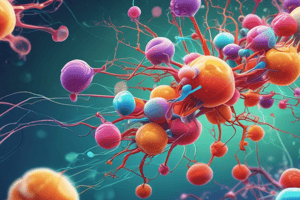Podcast
Questions and Answers
Which biomolecule is primarily responsible for storing and transmitting genetic information?
Which biomolecule is primarily responsible for storing and transmitting genetic information?
- Nucleic acids (correct)
- Carbohydrates
- Proteins
- Lipids
What type of bond is primarily responsible for the secondary structure of proteins?
What type of bond is primarily responsible for the secondary structure of proteins?
- Ionic bonds
- Disulfide bridges
- Hydrogen bonds (correct)
- Peptide bonds
Which class of biomolecules includes enzymes that catalyze biochemical reactions?
Which class of biomolecules includes enzymes that catalyze biochemical reactions?
- Proteins (correct)
- Nucleic acids
- Lipids
- Carbohydrates
Which of the following is not a function of lipids?
Which of the following is not a function of lipids?
What is the basic building block of proteins?
What is the basic building block of proteins?
Flashcards
Biomolecules
Biomolecules
Large molecules that are essential for life and are composed of smaller repeating units called monomers.
Carbohydrates
Carbohydrates
Organic compounds composed of carbon, hydrogen, and oxygen in a 1:2:1 ratio. They are the primary source of energy for living organisms.
Proteins
Proteins
Organic compounds composed of carbon, hydrogen, oxygen, and nitrogen. They are essential for building and repairing tissues.
Nucleic Acids
Nucleic Acids
Signup and view all the flashcards
Lipids
Lipids
Signup and view all the flashcards
Study Notes
Multiple Choice Questions (MCQs)
-
Which of the following is a monosaccharide? a) Sucrose b) Lactose c) Glucose d) Maltose
-
Which type of bond links amino acids together in a polypeptide chain? a) Glycosidic bond b) Peptide bond c) Ester bond d) Hydrogen bond
-
Which biomolecule is the primary source of energy for living organisms? a) Proteins b) Lipids c) Carbohydrates d) Nucleic acids
-
What is the primary function of carbohydrates? a) To store genetic information b) To catalyze biochemical reactions c) To provide structural support and energy d) To transport oxygen in the blood
-
What is the main component of cell membranes? a) Proteins b) Carbohydrates c) Lipids d) Nucleic acids
-
Which level of protein structure involves the folding of a polypeptide chain into a three-dimensional shape? a) Primary b) Secondary c) Tertiary d) Quaternary
-
What is the basic unit of a nucleic acid? a) Amino acid b) Nucleotide c) Fatty acid d) Monosaccharide
-
What are the two main types of nucleic acids? a) Lipids and proteins b) DNA and RNA c) Sugars and starches d) Cellulose and glycogen
-
Which type of lipid is a major component of cell membranes? a) Triglycerides b) Steroids c) Phospholipids d) Waxes
-
What is the function of enzymes in biochemical reactions? a) To store energy b) To provide structural support c) To catalyze biochemical reactions d) To transport molecules
-
Which of the following is an example of a disaccharide? a) Glucose b) Fructose c) Sucrose d) Ribose
-
What is the general formula for a simple carbohydrate? a) (CH₂O)n b) (C₂H₄O)n c) (C₃H₆O₃)n d) (C₅H₁₀O₅)n
-
What type of bond holds the two strands of a DNA molecule together? a) Peptide bonds b) Phosphodiester bonds c) Hydrogen bonds d) Ionic bonds
-
Which of the following is NOT a function of proteins? a) Catalyzing reactions b) Providing structural support c) Storing genetic information d) Transporting molecules
-
What is the primary role of lipids in the body? a) To carry genetic information b) To catalyze biochemical reactions c) To provide long-term energy storage d) To build structural components within the cell
-
What is the name of the process by which proteins lose their three-dimensional structure? a) Denaturation b) Replication c) Transcription d) Translation
-
Which type of lipid is often solid at room temperature? a) Unsaturated b) Saturated c) Polyunsaturated d) Monounsaturated
-
What are the building blocks of proteins? a) Sugars b) Fatty acids c) Amino acids d) Nucleotides
-
Which of the following is a polysaccharide? a) Glucose b) Fructose c) Starch d) Ribose
Study Notes
Carbohydrates
- Monosaccharides: Simple sugars (e.g., glucose, fructose, galactose).
- Disaccharides: Two monosaccharides joined together (e.g., sucrose, lactose, maltose).
- Polysaccharides: Many monosaccharides joined together (e.g., starch, glycogen, cellulose).
- Functions: Provide energy and structural support.
Lipids
- Types: Fats, oils, phospholipids, steroids.
- Structure: Contain carbon, hydrogen, and oxygen but have a lower proportion of oxygen than carbohydrates.
- Functions: Energy storage, insulation, hormone production, cell membrane structure.
Proteins
- Structure: Polymers of amino acids linked by peptide bonds.
- Four levels of structure: Primary, secondary, tertiary, quaternary.
- Functions: Enzymes, structural components, transport molecules, hormones, defense.
Nucleic Acids
- Structure: Polynucleotides.
- Types: DNA and RNA.
- Functions: Store and transmit genetic information.
General Features of Biomolecules
- Formation/Breaking: They undergo condensation (dehydration) reactions to form bonds and hydrolysis to break them apart.
- Importance: Essential for energy production, growth, and maintenance of life.
- Specificity: Their structure dictates function.
Studying That Suits You
Use AI to generate personalized quizzes and flashcards to suit your learning preferences.
Description
Test your knowledge on the structure and function of macromolecules, including carbohydrates, proteins, and lipids. This quiz covers essential concepts such as bond types, energy sources, and cellular components. Perfect for biology students looking to reinforce their understanding!



